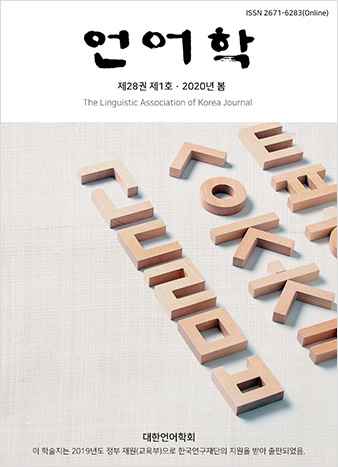대한언어학회 전자저널

28권 1호 (2020년 3월)
- 서비스 상황에서 한국인의 발화 개시 양상
-
안정근
Pages : 1-15
Abstract
Ahn, Jeong Khn. (2020). Opening utterances in service context for Koreans. The Linguistic Association of Korea Journal, 28(1), 1-15. This study examines the opening utterances in service industry contexts for Koreans. The service industry was divided into the public sector, such as community centers, provincial offices, and health centers and the private sector, such as cafes, banks, and stores, to investigate the differences in the utterances. The opening utterances in service were observed and written down by university students for a semester in 2019 and analyzed for their pattern and frequency in use. The findings in the study are as follows: For Koreans, as opening utterances in the public sector, 1) Mu-eos-eul do-wa-deu-lil-kka-yo? ('What can I help you?') and its variants are used most, 2) 'An-nyeong-ha-se-yo' ('Hello') the second most, 3) 'Eo-tteon-il-lo o-syeoss-eo-yo?' ('What for do you come?') and its variants the third most, 4) 'Eo-seo o-se-yo' ('Welcome') is followed by, and 5) 'Eo-tteoh-ge o-syeoss-eo-yo?' ('How do you come?') is used least. In private sector, on the other hand, 1) 'Eo-seo o-se-yo' and its variants are used most, 2) 'An-nyeong-ha-se-yo' the second most, 3) Mu-eos-eul do-wa-deu-lil-kka-yo? the third most, 4) 'Eo-tteon-il-lo o-syeoss-eo-yo?' and its variants are followed by, and 5) 'Eo-tteoh-ge o-syeoss-eo-yo?' ('How do you come?') is used least. The utterances but a few were initiated by the officers or employees in the service. This study contributes to the study of pragmatics for Koreans first investigating the features of opening utterances in service in depth and calling attention to the use of 'Eo-tteoh-ge o-syeoss-eo-yo?' which might be interpreted as Why do you come here?.
Keywords
# 한국인의 발화 개시(Korean’s opening utterances) # 서비스 상황에서 발화 개시(opening utterances in service)
References
- 노은희.(2004). 대화 지도를 위한 대화 시작부의 유형과 기능 연구. 청람어문교육, 30, 1-24.
- 안정근.(2015). 한국인의 거절화행 전략: 나이와 남녀 차이. 언어학, 23(1), 139-160.
- 이유미.(2017). 보험 상담대화의 신뢰 형성 전략. 국어교과교육연구, 30, 175-197.
- 전경하.(1993). 영한 담화 대조분석: 일상적 대화의 시작을 중심으로. 석사 학위논문, 서울대학교.
- 차정민.(2005). 한국어 교육을 위한 대화열기에서의 인사 연구: 문화소 이론과 문화심리학적 접근. 석사 학위논문, 연세대학교.
- 쿠라모치 카오루.(2013). 일한언어민 화자에 있어서 첫만남 대화의 특징 – 화제개시부를 중심으로. 일어일문학연구, 87(1), 259-285.
- Ahn, J. (2011). Cross-cultural variations of apology realization in Korean. The Sociolinguistic Journal of Korea, 19(2), 261-285.
- Ahn, J. (2012). Why do Koreans explain a lot when making an apology?. The Linguistic Association of Korea Journal, 20(3), 1-15.
- Blum-Kulka, S., House, J., & Kasper, G. (Eds.). (1989). Cross-cultural pragmatics: Requests and apologies. Norwood, New Jersey: Ablex Publishing Corporation.
- Kasper, G., & Blum-Kulka, S. (Eds.). (1993). Interlanguage pragmatics. Oxford: Oxford University Press.
- Lee, Y.(2015). The organizaton of phamacist-customer interaction in Korea. Unpublished masters’ thesis. Sungkyunkwan University, Seoul, Korea.
- Mey, J.(1993). Pragmatics: An introduction. Oxford: Blackwell.
- Park, Y.(2014). Openings in Korean primary care discourse: Where does it hurt?. Discourse and cognition, 21(1), 29-56.
- Sacks, H.(1992). Lectures on conversation. Oxford: Blackwell.
- Sinclair, J., & Coulthard, R.(1975). Towards an analysis of discourse. Oxford: Oxford University Press.
- Tannen, D.(1994). Gender and discourse. Oxford: Oxford University Press.